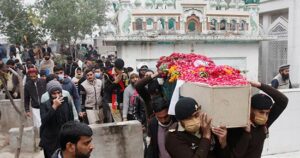Balochistan’s political elite has failed to take the ownership of national narrative to counter propaganda by terrorists
Over the last one year or so, there has been a marked change in the pattern of terrorist attacks in Balochistan. If earlier, the fringe sub-nationalist terrorist groups targeted non-local workers and labourers, in recent weeks and months, they are mounting attacks mainly on the security forces, particularly in far-flung border areas of the country’s southwestern province.
The latest example of these changing tactics was witnessed on February 2 when the terrorist stormed the security forces camps in Panjgur and Naushki. The security forces killed 20 terrorists after the attacks, in which nine security personnel embraced martyrdom.

The timing of these attacks coincided with Prime Minister Imran Khan’s planned visit to China on February 3 to attend the Winter Olympics in Beijing where he had to hold important top level meetings with the Chinese leadership, including President Xi Jinping. As Islamabad and Beijing aimed to push forward the second phase of the China-Pakistan Economic Corridor (CPEC), the terrorists wanted to threaten the Chinese to stay away from Balochistan, which is also the objective of India and other hostile nations.
Such terrorist acts, though challenging, failed to derail the CPEC in the past and are unlikely to stall them in future as both Pakistan and China stand committed to this mega initiative. Now, most of these attacks are carried out in areas close to the borders of either Iran or Afghanistan, where mobility is relatively easier for the terrorists.
However, against this backdrop, the shift in the pattern of attacks appears strategic and crucial to the narrative building of the terrorist groups, particularly on the social media, where many anti-Pakistan voices — from the vast Indian propaganda machine to the tiny segment of the westernised liberal Pakistanis — in one way or the other lend their support to the insurgents.
The situation becomes a little more complicated due to the lack of ownership of the state narrative by the political parties operating in Balochistan. The mainstream national parties, including the Pakistan Tehreek-e-Insaaf, the Pakistan Muslim League-Nawaz and the Pakistan People’s Party, lack the clout in provincial politics. They mainly depend on select tribal chiefs and elders for their symbolic presence in the province. However, this symbolic presence expands or evaporates with the change of loyalties of these influential local politicians. Among the national parties, the Jamiat Ulema-e-Islam-Fazl is an exception with its solid vote bank in select Pashtun-dominated districts.
For two reasons the nationalist and provincial parties, including the ruling Balochistan Awami Party, appear to lack focus and commitment in building a narrative against the violent sub-nationalist groups. The number one reason is that the leaders of these parties are too parochial and remain focused on constituency or at the most provincial-level politics. The second reason is that many of their politicians are afraid to openly criticize terrorist groups and their tribal patrons because of the threat to their lives. For example, several local leaders and workers of the pro-federation National Party were killed by terrorists in recent years.
Then there are other parties, including the Balochistan National Party-Mengal, which by design or default indirectly supports the narratives of the terrorist groups rather than out-rightly rejecting and condemning their acts.
The state is represented overwhelmingly by the security forces, which try to fill in the vacuum as the political parties and the elected representatives fail not just to provide a national vision but also address the basic problems in their constituencies despite the injection of hefty amounts of development funds, the bulk of which unfortunately get misappropriated. This, in turn, fans more discontent and deprivation among the people.
The political establishment has failed to take measures to create job opportunities for the educated youth of Balochistan, where in recent years, several impressive high education institutions have been established. This fuels discontent and makes it easier for the anti-Pakistan element to misguide the youth.
Balochistan also does not find much space on the mainstream national media because it hardly has any commercial stake there. As a result, the problems, issues and aspirations of the people of Balochistan hardly get space on the national media which superfluously focuses on this province only when there is some trouble, natural calamity or terrorist attack.
While the security forces are focused on hunting down terrorists, the most crucial elements of bringing peace in Balochistan appears to be missing; integrating the province in the national narrative, creating job opportunities for the youth and carrying out development work.




Comments are closed.